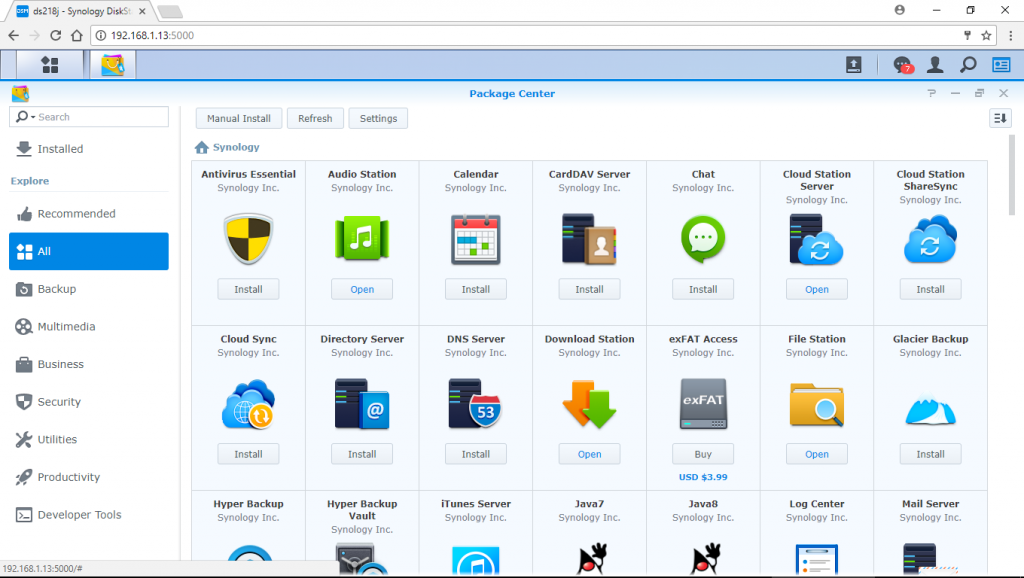
You can start out with a base unit and a few hard drives and once your storage needs grow, you can either add more drives or replace them with higher capacity ones. What I love about the DS1815+ is its versatility. You can host your own WordPress site and even use the Synology DS1815+ as your home iTunes server. Speaking of apps, that’s the beauty of Synology NAS devices – we are not just talking about a pure storage device, but a pretty robust server that can host a number of web server applications for backup, file hosting, scripting and much more. The unit runs on a Quad Core 2.4 Ghz Intel Atom C2538 processor and although the base unit comes with 2 GB of RAM, if you run a lot of apps and you need more memory, you can increase it to 6 GB with a 4 GB DDR 3 stick. On its own you can reach up to 64 TB capacity (with 8x 8 TB drives) and if you add up two DX513 expansion units, you can reach up to 108 TB of total capacity with 18 drives, which is insane. It sits in the “Small and Medium Business” line of products, because it can accommodate up to eight 3.5″ drives and has a very robust and scalable architecture that can handle a lot of storage and traffic. The DS1815+ is one of the many NAS devices offered by Synology. Automated Backups to Another Synology Array.Let’s go over the specifications and what the unit is capable of first. In this review, I will be taking a closer look at the Synology DS1815+ and talk about my experience using the unit for my work during the past 6 months. Since implementation, my friend and his co-workers have been very happy, praising Synology and recommending the company to others.
Synology cloud station drive review professional#
I have personally used a number of Synology NAS devices in the past both on personal and professional levels and I have always loved the architecture, the simple to use software, the reliability and the performance of Synology storage solutions. Having been working with storage solutions for many years, my proposal was to use the Synology DS1815+ network attached storage (NAS) in a Gigabit network environment. He told me about the challenges his team was experiencing when needing to share photos and videos in a network environment, often resorting to very slow and ineffective methods that only created frustration. Last year, a good friend of mine, who has been doing both photography and videography professionally for a number of years now, asked me for a suggestion on a solid and robust storage solution that could be used in a workgroup environment, with more than 2 people accessing the same data simultaneously. The process of selecting the best solution is often frustrating for many photographers for this particular reason. The bad news is, even when you know exactly what you need in terms of storage space, you might find yourself lost fairly quickly, particularly if you are not well-versed in storage solutions. The good news is, there is a solution for practically every need out there – from a simple low-cost backup solution to high-end and versatile storage arrays for multi-user environments, all depending on one’s needs. If this happens again, I will raise the issue with Synology.Choosing the right storage option can be a rather challenging process due to the sheer number of options available on the market today. This is obviously pretty serious issue as it leaves synced folders in inconstant state while displaying that everything is is sync.

Synology cloud station drive review Pc#
After this, the affected PC would immediately upload the file back and Cloud Station would then sync it across all other drives. The work around was to delete the affected file from File Station web interface (make a backup first).


Again, Cloud Station on all devices would think that everything was in sync. One thing I noticed was that when the file was deleted from the affected device, other devices syncing the same folder (including File Station on the NAS itself) would still show the file in its place and all devices were displaying that folder was in sync! In a similar way, if the file was renamed on the affected device, other devices (and File Station) would show both files (original and renamed), but the affected PC would only have the renamed version. Deleting the file(s) would put the drive seemingly back in sync, but trying to copy the file back would cause the same issue.


 0 kommentar(er)
0 kommentar(er)
